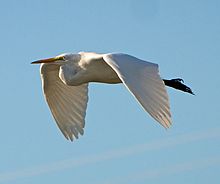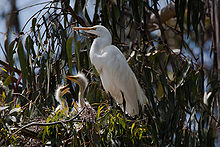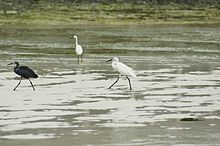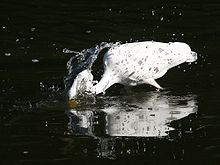- Great Egret
-
For the similar Australasian species, see Eastern Great Egret.
Great Egret 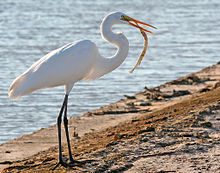
Adult in nonbreeding plumage Conservation status Scientific classification Kingdom: Animalia Phylum: Chordata Class: Aves Order: Pelecaniformes Family: Ardeidae Genus: Ardea Species: A. alba Binomial name Ardea alba
Linnaeus, 1758Synonyms Casmerodius albus
Egretta albaThe Great Egret (Ardea alba), also known as the Great White Egret or Common Egret, White Heron, or (now not in use) Great White Heron,[2][3] is a large, widely-distributed egret. Distributed across most of the tropical and warmer temperate regions of the world, in southern Europe it is rather localized. In North America it is more widely distributed, and it is ubiquitous across the Sun Belt of the United States and in the rainforests of South America. It is sometimes confused with the Great White Heron in Florida, which is a white morph of the closely related Great Blue Heron (A. herodias). Note, however, that the name Great White Heron has occasionally been used to refer to the Great Egret.
Contents
Description
The Great Egret is a large bird with all-white plumage that can reach one meter in height, weigh up to 950 grams (2.1 lb) and a wingspan of 165 to 215 cm (65 to 85 in). It is thus only slightly smaller than the Great Blue or Grey Heron (A. cinerea). Apart from size, the Great Egret can be distinguished from other white egrets by its yellow bill and black legs and feet, though the bill may become darker and the lower legs lighter in the breeding season. In breeding plumage, delicate ornamental feathers are borne on the back. Males and females are identical in appearance; juveniles look like non-breeding adults. It is a common species, usually easily seen.
It has a slow flight, with its neck retracted. This is characteristic of herons and bitterns, and distinguishes them from storks, cranes, ibises, and spoonbills, which extend their necks in flight.
The Great Egret is not normally a vocal bird; at breeding colonies, however, it often gives a loud croaking cuk cuk cuk.
Systematics and taxonomy
Like all egrets, it is a member of the heron family, Ardeidae. Traditionally classified with the storks in the Ciconiiformes, the Ardeidae are closer relatives of pelicans and belong in the Pelecaniformes instead. The Great Egret—unlike the typical egrets—does not belong to the genus Egretta but together with the great herons is today placed in Ardea. In the past, however, it was sometimes placed in Egretta or separated in a monotypic genus Casmerodius.
Subspecies
There are four subspecies in various parts of the world, which differ but little. Differences are bare part coloration in the breeding season and size; the largest A. a. modesta from Asia and Australasia some taxonomists consider a full species, the Eastern Great Egret (Ardea modesta).:
- Ardea alba alba (Europe)
- Ardea alba egretta (Americas)
- Ardea alba melanorhynchos (Africa)
- Ardea alba modesta (India, Southeast Asia, and Oceania)
Ecology and status
The Great Egret is partially migratory, with northern hemisphere birds moving south from areas with colder winters. It breeds in colonies in trees close to large lakes with reed beds or other extensive wetlands. It builds a bulky stick nest.
The Great Egret is generally a very successful species with a large and expanding range. In North America, large numbers of Great Egrets were killed around the end of the 19th century so that their plumes could be used to decorate hats. Numbers have since recovered as a result of conservation measures. Its range has expanded as far north as southern Canada. However, in some parts of the southern United States, its numbers have declined due to habitat loss. Nevertheless, it adapts well to human habitation and can be readily seen near wetlands and bodies of water in urban and suburban areas. In 1953 the Great Egret in flight was chosen as the symbol of the National Audubon Society, which was formed in part to prevent the killing of birds for their feathers.[4][5]
The Great Egret is one of the species to which the Agreement on the Conservation of African-Eurasian Migratory Waterbirds (AEWA) applies.
Diet
The Great Egret feeds in shallow water or drier habitats, feeding mainly on fish, frogs, small mammals, and occasionally small reptiles and insects, spearing them with its long, sharp bill most of the time by standing still and allowing the prey to come within its striking distance of its bill which it uses as a spear. It will often wait motionless for prey, or slowly stalk its victim.
Though it might appear that they feed on the parasites of African buffaloes, they actually feed on leafhoppers, grasshoppers and other insects which are stirred up as buffaloes move about in water.[6]
In culture
The Great Egret is depicted on the reverse side of a 5-Brazilian reais banknote.
White Egrets is the title of Saint Lucian Poet Derek Walcott's fourteenth collection of poems.
Footnotes
- ^ BirdLife International (2010). "Casmerodius albus". IUCN Red List of Threatened Species. Version 3.1. International Union for Conservation of Nature. http://www.iucnredlist.org/apps/redlist/details/144681. Retrieved March 6, 2011.
- ^ Thomas Bewick (1809). "The Great White Heron (Ardea alba, Lin. – Le Heron blanc, Buff.)". Part II, Containing the History and Description of Water Birds. A History of British Birds. Newcastle: Edward Walker. p. 52. http://www.biodiversitylibrary.org/item/82314#page/386/mode/1up.
- ^ B. Bruun, H. Delin, L. Svenson. The Hamlyn Guide to Birds to Britain and Europe. London, 1970, 36.
- ^ "Timeline of Accomplishments". National Audubon Society. http://www.audubon.org/timeline-accomplishments. Retrieved March 6, 2011.
- ^ "Historical Highlights: Signature Species". National Audubon Society. Archived from the original on March 30, 2009. http://replay.waybackmachine.org/20090330082257/http://audubon.org/centennial/species.php. Retrieved March 6, 2011.
- ^ Tom McHugh (1979). "The grassland community". The Time of the Buffalo. University of Nebraska Press. p. 232. ISBN 9780803281059. http://books.google.com/books?id=xSbrXXh0lWMC&pg=PA232.
References
- Roger Tory Peterson (1998). Eastern Birds. Peterson Field Guides (4th ed.). New York: Houghton Mifflin. p. 102. ISBN 9780395911761.
- David W. Snow, Christopher M. Perrins, Paul Doherty & Stanley Cramp (1998). The Complete Birds of the Western Palaearctic on CD-ROM. Oxford University Press. ISBN 0192685791.
External links
- The Great White Egret Image documentation
- Great Egret Information – Cornell Lab of Ornithology
- Great Egret Information and Photos – South Dakota Birds and Birding
- Great Egret Information – USGS Patuxent Bird Identification InfoCenter
- Ardea alba in the Flickr: Field Guide Birds of the World
- Ardea alba on Avibase
Categories:- IUCN Red List least concern species
- Herons
- Ardea
- Animals described in 1758
- Birds of North America
- Birds of Europe
- Birds of Southeast Asia
Wikimedia Foundation. 2010.


